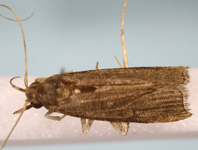Abstract
A survey of myxomycete diversity on five islands of the Seychelles yielded 105 species and 10 infra-specific taxa, which included 89 species on La Digue, 66 on Praslin, 63 on Mahé, 31 on Curieuse and 4 on Félicité. Among these records, 64 species are new for the Seychelles and together with data from the literature, 143 species of myxomycetes are now known for all of the Seychelles. Most collecting on all five islands was carried out in low elevation areas. Forty-four species (73% of all specimens of myxomycetes) were found in low-elevation localities, and among these were Arcyria helvetica, Dictydiaethalium dictyosporum, Echinostelium paucifilum, Physarum aeneum, Ph. echinosporum, Reticularia olivacea, and Stemonaria longa. From 54 species of plants used by myxomycetes as substrates, eight species provided 63% of the specimens of myxomycetes, with most samples recorded from Calophyllum inophyllum. On the basis of substrate type, myxomycetes were distributed as follows: 37% of specimens were collected on dead wood and decaying palm stems, 16% on the bark and stems of living plants, 25% on ground litter, and 22% on aerial litter. A comparison of the assemblages of myxomycetes found in zones with different levels of human impact indicated that 84 species were found in forests, 74 in anthropogenic areas, and 62 in recreational coastal areas. The Seychelles provide a good background for a high level of myxomycete diversity, as a consequence of favorable climatic conditions and their location between Asia and Africa.
References
Adamonyte, G., Stephenson, S.L., Michaud, A., Seraoui, E-H., Meyer, M., Novozhilov, Y.K. & Krivomaz, T. (2011) Myxomycete species diversity on the island of La Réunion (Indian Ocean). Nova Hedwigia, 92 (3–4), 523–549.
https://doi.org/10.1127/0029-5035/2011/0092-0523
Cox, C.B., Moor, P.D. & Ladle, R.J. (2016) Biogeography: An Ecological and Evolutionary Approach. 9th Edition. Blackwell Science, Oxford, 494 pp.
Discover Life (2018) Eumycetozoa. International Center for Public Health and Environmental Reseach (PHER), USA. Available from http://www.discoverlife.org/ (accessed 1 August 2019)
Fleischmann, K., Héritier, P., Meuwly, C., Küffer, C. & Edwards, P.J. (2003) Virtual gallery of the vegetation and flora of the Seychellles. Bulletin of the Geobotanical Institute ETH, 69, 57–64.
Fleischmann, K., Porembski, S., Biedinger, N. & Barthlott, W. (1996) Inselbergs in the sea: Vegetationof granite outcrops on the islands of Mahé, Praslin and Silhouette (Seychelles). Bulletin of the Geobotanical Institute ETH, 62, 61–74.
Franda, M. (2019) The Seychelles: Unquiet Islands. Routledge, New York, 140 pp.
https://doi.org/10.4324/9780429314513
Hansen, S.G. & Laboudallon, V.F. (2013) Flora of the Seychelles. A Field Guide to
Selected Plants. Trykkeriet Friheden Aps, Thisted, 663 pp.
Hill, M.J. (2002) Biodiversity Surveys and Conservation Potential of Inner Seychelles Islands. National Museum of Natural History, Smithsonian Institution, Washington, 272 pp.
https://doi.org/10.5479/si.00775630.495
Ing, B. & Hnatiuk, R.J. (1981) Myxomycetes of Aldabra Atoll. Atoll Research Bulletin, 249, 1–10.
https://doi.org/10.5479/si.00775630.249.1
Kryvomaz, Т., Michaud, A. & Stephenson, S.L. (2017) First survey of Myxomycetes on Mahé Island in the Seychelles. Nova Hedwigia, 104 (1–3), 65–84.
https://doi.org/10.1127/nova_hedwigia/2015/0289
Lado, C., Estrada-Torres, A., Stephenson, S.L., Wrigley de Basanta, D. & Schnittler, M. (2003) Biodiversity assessment of myxomycetes from two tropical forest reserves in Mexico. Fungal Diversity, 12, 67–110.
Lado, C. (2005–2019) An online nomenclatural information system of Eumycetozoa. Available from http://www.nomen.eumycetozoa.com (accessed 1 August 2019)
Lado, C. & Wrigley de Basanta, D. (2008) A review of Neotropical myxomycetes (1828–2008). Anales del Jardín Botánico de Madrid, 65 (2), 211–254.
https://doi.org/10.3989/ajbm.2008.v65.i2.293
Lado, C., Wrigley de Basanta, D., Estrada-Torres, A. & Stephenson, S.L. (2016) Myxomycete diversity in the coastal desert of Peru with emphasis on the lomas formations Localización. Anales del Jardín Botánico de Madrid, 73 (1), 1–27.
https://doi.org/10.3989/ajbm.2436
Lado, C., Estrada-Torres, A., Wrigley de Basanta, D., Schnittler, M. & Stephenson, S.L. (2017) A rapid biodiversity assessment of myxomycetes from a primary tropical moist forest of the Amazon basin in Ecuador Source. Nova Hedwigia, 104 (1–3), 293–321.
https://doi.org/10.1127/nova_hedwigia/2016/0372
Merlin, A., Senterre, B. & Francisco, E. (2012) Seychelles Plant Gallery. National History Museum, Victoria, Seychelles. Available from http://www.seychellesplantgallery.com (accessed 1 August 2019)
Poulain, M., Meyer, M. & Bozonnet, J. (2011) Les Myxomycètes. 2 Vols. Sarl Editions FMDS, Delémont, 1119 pp.
Republic of Seychelles Statistical Abstract (2016) Republic of Seychelles Statistical Abstract. National Bureau of Statistics, Mahe, Victoria, 151 pp.
Sauer, J.D. (1967) Plants and Man on the Seychelles Coast. A Study in Historical Biogeography. The University of Wisconsin Press, Madison, London, 132 pp.
Sørensen, T. (1948) A method of establishing groups of equal amplitude in plant sociology based on similarity of species and its application to analyses of the vegetation on Danish commons. Kongelige Danske Videnskabernes Selskab, 5 (4), 1–34.
Stephenson, S.L. & Rojas, C. (2017) Myxomycetes Biology, Systematics, Biogeography and Ecology. 1st Edition. Academic Press, London, 474 pp.
Stephenson, S.L., Kalyanasundaram, I. & Lakhanpal, T.N. (1993) A Comparative biogeographical study of Myxomycetes in the mid-Appalachians of eastern North America and two regions of India. Journal of Biogeography, 20 (6), 645.
https://doi.org/10.2307/2845520
Stephenson, S.L., Schnittler, M. & Lado, C. (2004) Ecological characterization of a tropical myxomycete assemblage: Maquipucuna Cloud Forest Reserve, Ecuador. Mycologia, 96 (4), 488–497.
https://doi.org/10.1080/15572536.2005.11832948
Stoddart, D.R. (1984) Biogeography and Ecology of the Seychelles Islands. Monographiae Biologicae, Boston & Lancaster, 691 pp.
UNEP (2011) Nagoya Protocol on Access to Genetic Resources and the Fair and Equitable Sharing of Benefits Arising From Their Utilization to the Convention on Biological Diversity. Secretariat of the Convention on Biological Diversity, Montreal, Canada, 25 pp.
Wrigley de Basanta, D., Stephenson, S.L., Lado, C., Estrada-Torres, A. & Nieves-Rivera, A.M. (2008) Lianas as a microhabitat for myxomycetes in tropical forests. Fungal Diversity, 28, 109–125.
Wrigley de Basanta, D., Lado, C., Estrada-Torres, A. & Stephenson, S.L. (2010) Biodiversity of myxomycetes in subantarctic forests of Patagonia and Tierra del Fuego, Argentina. Nova Hedwigia, 90, 45–79.
https://doi.org/10.1127/0029-5035/2010/0090-0045
Wrigley de Basanta, D., Lado, C., Estrada-Torres, A. & Stephenson, S.L. (2013) Biodiversity studies of Myxomycetes in Madagascar. Fungal Diversity, 59, 55–83.


